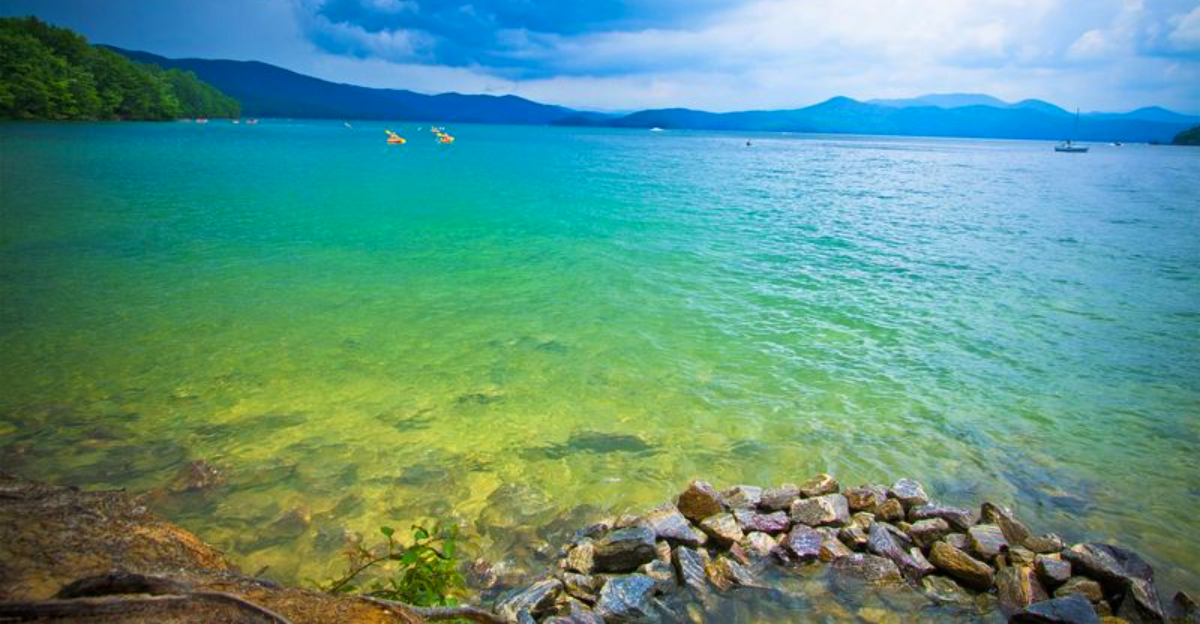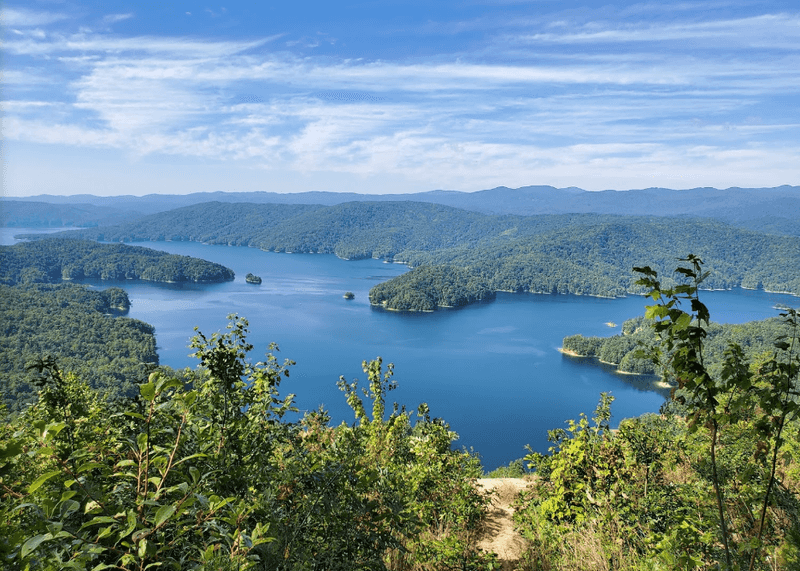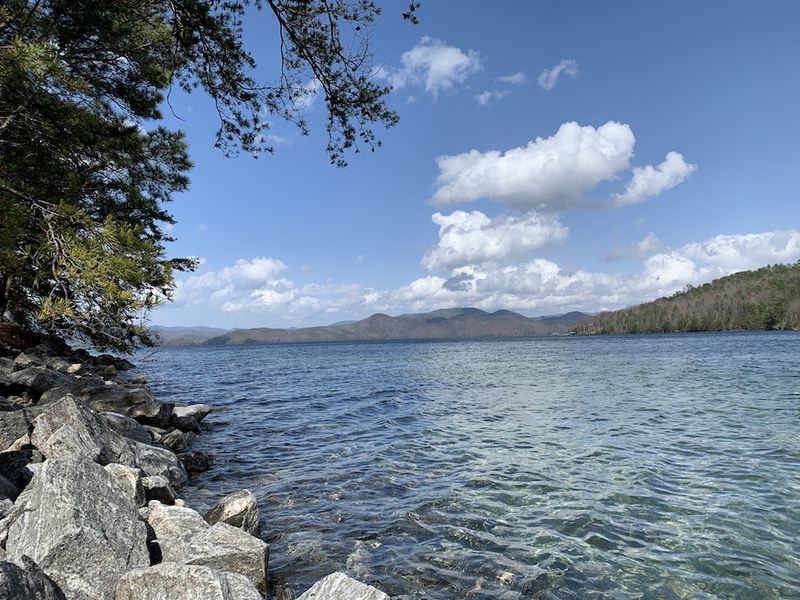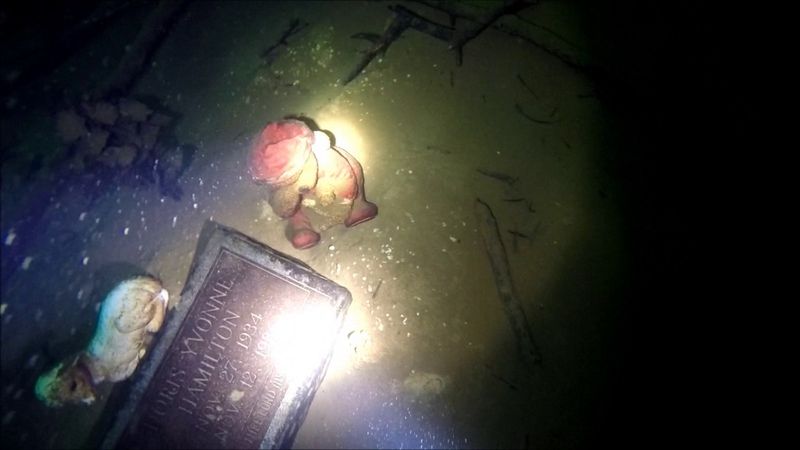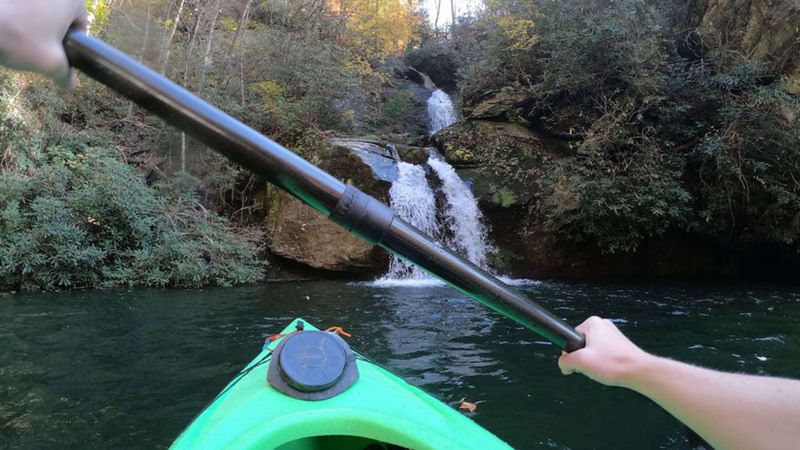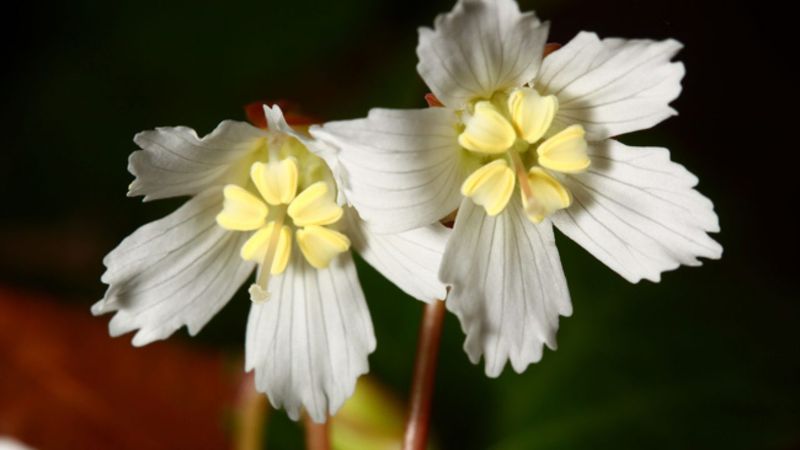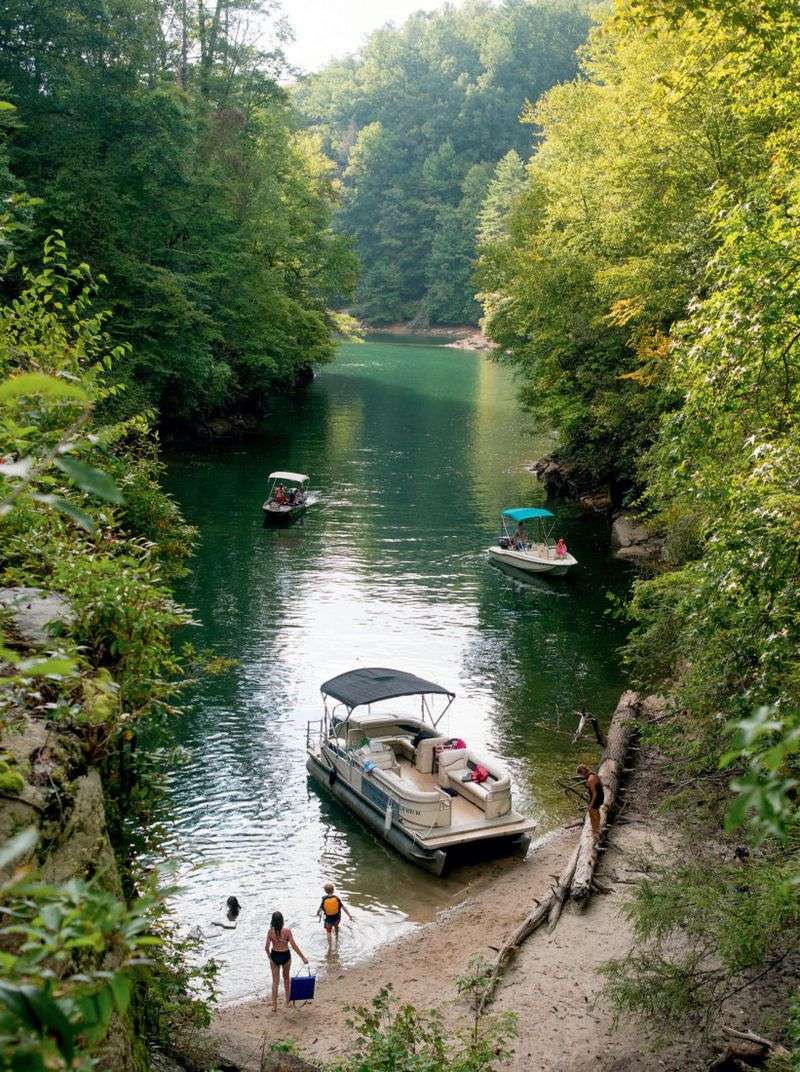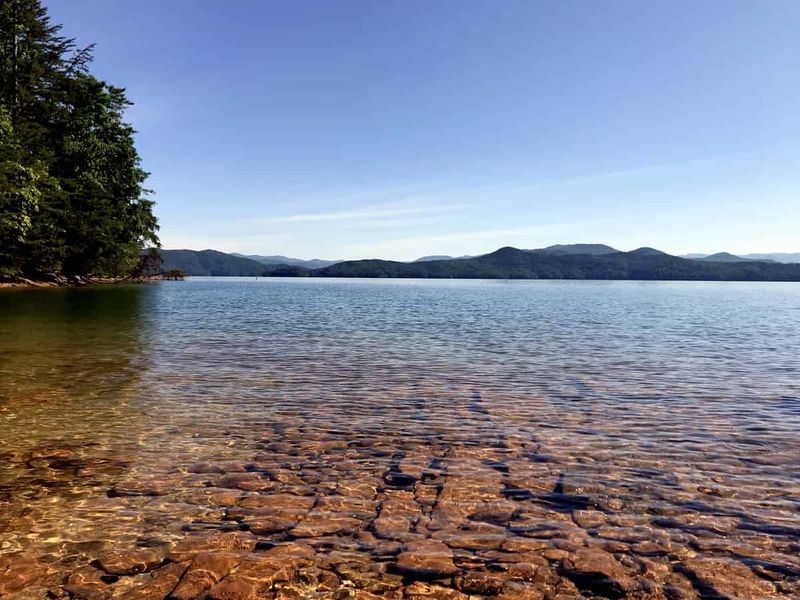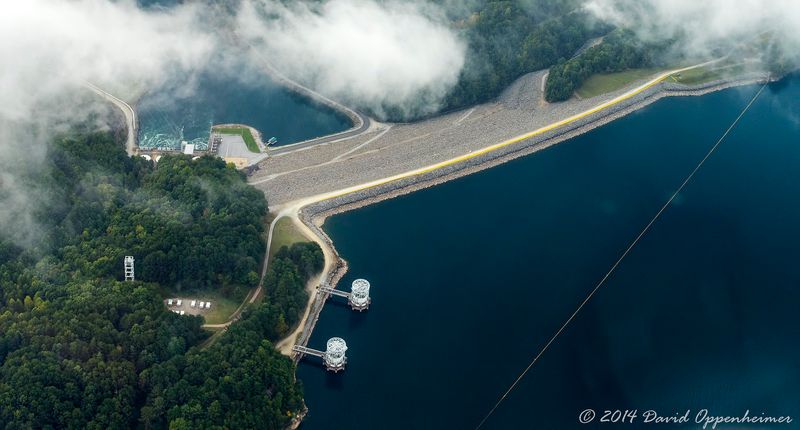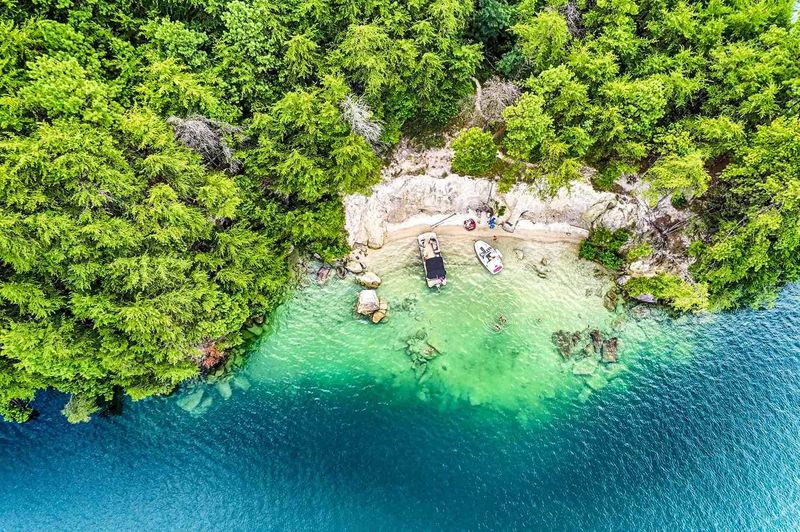Hidden in the Blue Ridge Mountains of South Carolina lies a lake so clear and mysterious that it feels like stepping into another world. Lake Jocassee isn’t just any ordinary body of water; beneath its stunning turquoise surface rests a forgotten valley complete with old buildings and stories from the past. With waterfalls tumbling down steep cliffs and wildlife thriving in the surrounding forests, this secret gem offers adventure seekers and nature lovers an unforgettable escape into one of the Southeast’s most beautiful landscapes.
1. Man-made mountain lake
Lake Jocassee wasn’t always here. Back in 1973, Duke Energy built the Jocassee Dam, which flooded a beautiful mountain valley and created this massive reservoir spanning about 7,500 acres.
Four rivers came together to fill this new lake: the Horsepasture, Toxaway, Whitewater, and Thompson. Each river brought cold mountain water rushing down from the high peaks above.
The result is a stunning artificial lake that looks completely natural. Today, it’s hard to imagine that this peaceful water haven didn’t exist just fifty years ago, yet it has become one of South Carolina’s most treasured outdoor destinations.
2. Spectacular water clarity and color
One look at Lake Jocassee and you might think you’ve been transported to the Caribbean. The water shimmers in brilliant shades of turquoise and emerald, looking more like a tropical paradise than a mountain lake.
Cold mountain streams and waterfalls constantly feed fresh water into the lake, keeping it incredibly clean and cool year-round. Travel writers have called it “Caribbean-clear” because you can see so far down into the depths.
Unlike many murky lakes in the Southeast, Jocassee’s exceptional clarity makes it perfect for underwater exploration. Swimmers and divers love the refreshing coolness and the ability to see clearly through the pristine water.
3. Deep and rugged terrain
Plunging to depths between 300 and 350 feet, Lake Jocassee ranks among the deepest lakes in the entire Southeast. The steep mountain terrain surrounding the water creates dramatic underwater landscapes that thrill divers and scientists alike.
Massive rock formations and underwater cliffs mirror the rugged peaks visible above the surface. This creates a fascinating three-dimensional world beneath the waves that few people ever get to witness firsthand.
The extreme depth keeps the water cold even during hot summer months. Bottom temperatures stay chilly year-round, creating perfect conditions for cold-water fish species that normally couldn’t survive this far south in warmer climates.
4. Limited public access, undeveloped shoreline
Most of Lake Jocassee’s shoreline remains completely wild and undeveloped, which is extremely rare for such a beautiful lake. Unlike crowded tourist destinations, you won’t find rows of vacation homes or busy marinas cluttering the landscape here.
Devils Fork State Park serves as the only public access point to the lake. This controlled entry helps protect the natural environment and keeps visitor numbers manageable throughout the year.
The limited access might seem inconvenient at first, but it’s actually a blessing. Because fewer people can reach the lake, it maintains a pristine wilderness character that disappeared from most popular lakes decades ago, offering true solitude.
5. Submerged structures and ghost-town legacy
Before the dam flooded the valley in 1973, a small community thrived here with homes, hunting camps, and the famous Attakulla Lodge. When the water rose, these buildings weren’t demolished but simply left to sink beneath the surface.
Today, adventurous scuba divers explore these eerie underwater ruins. Stone chimneys, building foundations, and old roads still exist on the lake bottom, creating an haunting underwater ghost town frozen in time.
These submerged structures tell stories of families who once called this valley home. Exploring them offers a unique window into the past and reminds visitors that beautiful Lake Jocassee came at the cost of a vanished community.
6. Name meaning and Native American legend
The name “Jocassee” comes from an ancient Cherokee legend and translates to “Place of the Lost One.” This haunting name carries deep meaning for the Native Americans who lived in this valley for countless generations before European settlers arrived.
Cherokee people considered this land sacred and told stories about it around their fires. The legend speaks of love, loss, and tragedy that unfolded in these mountains long ago.
When the valley flooded, it wasn’t just modern homes that disappeared underwater. The lake also covered ancient Cherokee territories and historical sites, adding another layer to the area’s already mysterious and melancholy atmosphere that visitors sense today.
7. Breathtaking waterfalls feed into the lake
Numerous waterfalls plunge dramatically from the surrounding cliffs straight into Lake Jocassee’s waters. The sight and sound of these cascades creates an almost magical atmosphere that photographers and nature lovers find irresistible.
Some waterfalls can only be reached by boat, making them feel like secret discoveries. Paddling your kayak right up to where a waterfall meets the lake creates an unforgettable experience you won’t find at many other destinations.
These waterfalls don’t just look beautiful; they constantly supply the lake with fresh, cold mountain water. This continuous flow helps maintain the exceptional water quality and clarity that makes Lake Jocassee so special and different from typical reservoirs.
8. Rare plants and biodiversity
The forests surrounding Lake Jocassee contain botanical treasures found almost nowhere else on Earth. The rare Oconee Bell wildflower grows in these mountains, attracting botanists and wildflower enthusiasts from around the world each spring.
High rainfall amounts create conditions similar to a temperate rainforest. Moss-covered trees, diverse ferns, and countless plant species thrive in the moist, cool environment that the mountains and lake create together.
This biological richness makes the area important for conservation. Scientists study the unique ecosystem to understand how rare species survive and what we can do to protect them for future generations to discover and enjoy.
9. Excellent for fishing and outdoor recreation
Anglers travel from across the country to fish Lake Jocassee’s pristine waters. The cold, clean environment supports healthy populations of trout, bass, and other game fish that grow large and fight hard when hooked.
Beyond fishing, the lake offers incredible opportunities for kayaking, stand-up paddleboarding, scuba diving, and swimming. The dramatic cliffs and clear water create a stunning backdrop for any water activity you can imagine.
Hiking trails wind through the surrounding mountains, offering spectacular views of the lake from above. Whether you prefer being on the water or exploring the forests, Lake Jocassee delivers outdoor adventures that satisfy every type of nature enthusiast.
10. Remote, tranquil atmosphere
Located deep in the rugged Jocassee Gorges region, this lake offers something increasingly rare in our busy world: genuine peace and quiet. The limited access keeps crowds away, creating an atmosphere of solitude that stressed-out visitors find deeply healing.
Unlike popular lakes where jet skis buzz constantly and music blares from crowded beaches, Jocassee maintains a respectful calm. You’re more likely to hear birdsong and wind in the trees than human noise.
This tranquil character makes Lake Jocassee perfect for people seeking to disconnect from technology and reconnect with nature. The remote location might require extra effort to reach, but that journey rewards you with an authentic wilderness experience.
11. Hydroelectric importance
Lake Jocassee isn’t just a pretty face; it works hard as part of Duke Energy’s pumped-storage hydroelectric system. This clever technology helps balance electricity supply and demand across the region, storing energy when it’s abundant and releasing it when needed.
The system pumps water uphill to a higher reservoir during off-peak hours, then releases it back down through turbines to generate electricity during peak demand. It’s like a giant rechargeable battery made of water and gravity.
This dual purpose shows how recreation and utility can coexist successfully. While the dam generates clean, renewable energy for thousands of homes, people still enjoy the beautiful lake it created for camping, boating, and exploring nature.
12. Ideal seasonal suggestions
While Lake Jocassee welcomes visitors throughout the year, certain seasons offer special rewards. Spring transforms the surrounding forests into a wildflower wonderland, with rare blooms like the Oconee Bell emerging after winter’s chill.
Summer brings perfect conditions for water activities. The cool lake water provides refreshing relief from southern heat, and long daylight hours give you plenty of time to explore hidden coves and waterfalls by boat.
Fall offers spectacular foliage as mountain hardwoods turn brilliant colors, while winter brings solitude and stark beauty. Each season reveals a different personality, so consider what experience you want when planning your visit to this remarkable mountain lake.
